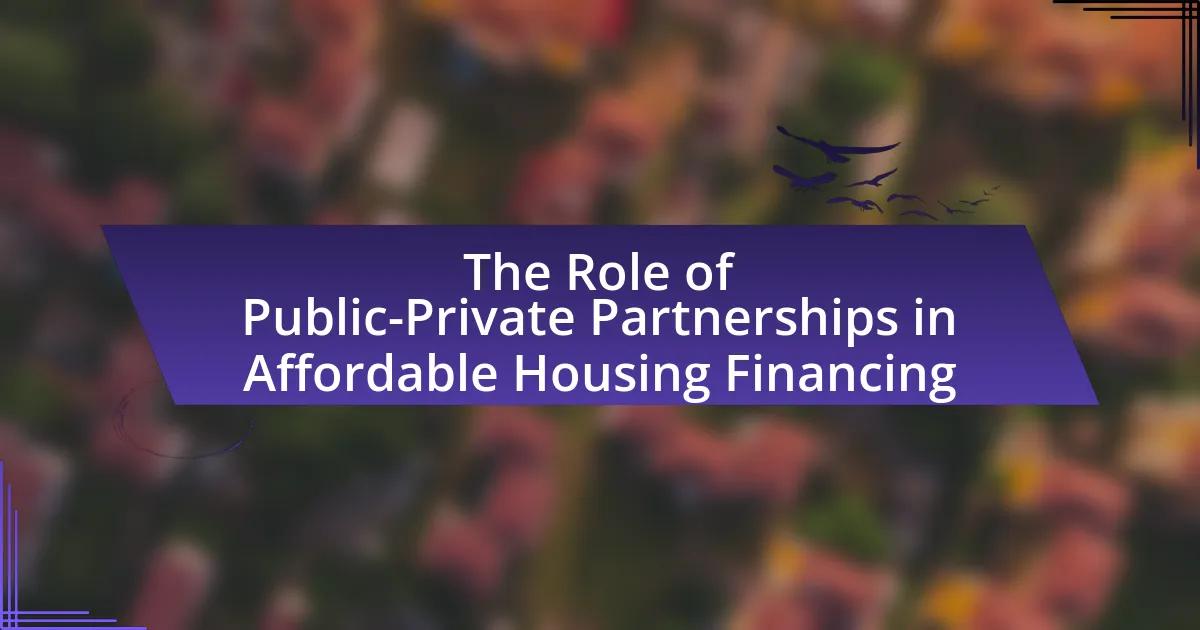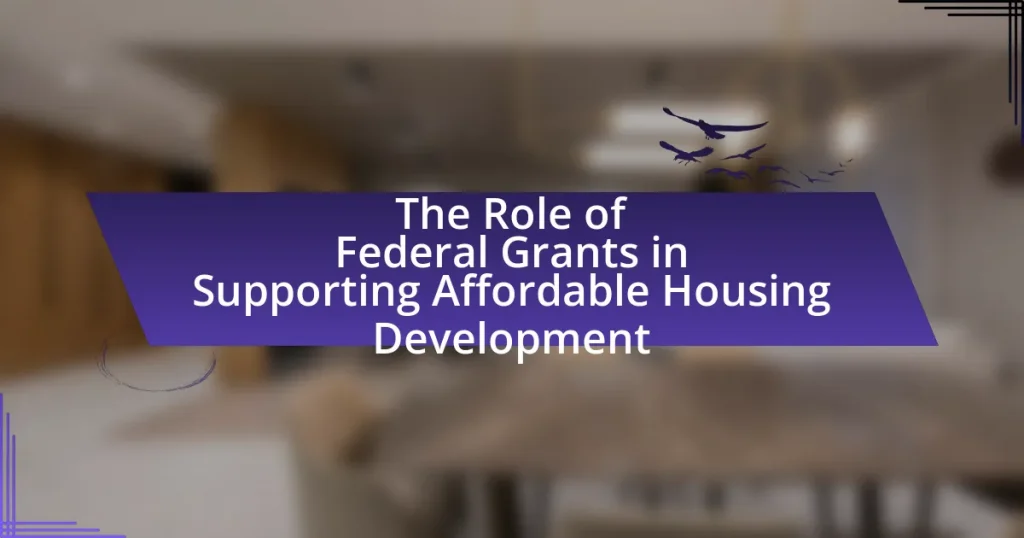Public-Private Partnerships (PPPs) play a crucial role in affordable housing financing by facilitating collaboration between government entities and private sector companies to develop and manage housing projects. This article outlines how PPPs function, highlighting key components such as risk-sharing, investment collaboration, and regulatory frameworks that enhance project viability. It also discusses various models of PPPs, their strengths and weaknesses, and the impact of government policies on their effectiveness. Additionally, the article addresses challenges faced by these partnerships, including funding limitations and misalignment of goals, while proposing best practices for improving collaboration and stakeholder engagement to achieve better outcomes in affordable housing initiatives.

What are Public-Private Partnerships in Affordable Housing Financing?
Public-Private Partnerships (PPPs) in affordable housing financing are collaborative agreements between government entities and private sector companies aimed at developing and managing affordable housing projects. These partnerships leverage public resources and private investment to address housing shortages and improve living conditions. For instance, according to the National Council for Public-Private Partnerships, such collaborations can enhance efficiency, reduce costs, and expedite project delivery, ultimately increasing the availability of affordable housing units.
How do Public-Private Partnerships function in the context of affordable housing?
Public-Private Partnerships (PPPs) function in the context of affordable housing by combining resources and expertise from both the public and private sectors to develop, finance, and manage housing projects. These collaborations leverage public funding and regulatory support alongside private investment and innovation, facilitating the creation of affordable housing units. For instance, in the United States, the Low-Income Housing Tax Credit program incentivizes private developers to invest in affordable housing by providing tax credits, which has resulted in the construction of over 3 million affordable housing units since its inception in 1986. This model allows for risk-sharing, efficient project delivery, and the ability to meet community housing needs effectively.
What are the key components of Public-Private Partnerships in this sector?
The key components of Public-Private Partnerships (PPPs) in affordable housing financing include risk sharing, investment collaboration, and regulatory frameworks. Risk sharing allows both public and private entities to distribute financial and operational risks associated with housing projects, enhancing project viability. Investment collaboration involves pooling resources and expertise from both sectors to fund and develop housing initiatives, which can lead to more innovative solutions and efficient use of capital. Regulatory frameworks establish the legal and operational guidelines that govern the partnership, ensuring compliance and alignment with public policy objectives. These components are essential for creating effective and sustainable partnerships that address the affordable housing crisis.
How do these components interact to facilitate affordable housing financing?
Public-private partnerships (PPPs) facilitate affordable housing financing by combining resources, expertise, and risk-sharing between government entities and private developers. These collaborations enable the pooling of financial resources, where public funding can be used to leverage private investment, thus reducing the overall cost of housing projects. For instance, in the United States, the Low-Income Housing Tax Credit program incentivizes private developers to invest in affordable housing by providing tax credits, which has resulted in the creation of over 3 million affordable housing units since its inception in 1986. Additionally, PPPs streamline the regulatory process, allowing for faster project approvals and reducing time-to-market for affordable housing developments. This interaction between public support and private investment is crucial in addressing the housing crisis and ensuring that affordable options are available to low- and moderate-income families.
Why are Public-Private Partnerships important for affordable housing?
Public-Private Partnerships (PPPs) are important for affordable housing because they leverage resources, expertise, and risk-sharing between the public and private sectors to create sustainable housing solutions. By combining public funding and regulatory support with private investment and innovation, PPPs can accelerate the development of affordable housing projects. For instance, a study by the Urban Institute found that PPPs can reduce project costs by up to 20% through efficient resource allocation and streamlined processes. This collaboration not only increases the quantity of affordable housing available but also enhances the quality and sustainability of these developments, addressing the growing housing crisis effectively.
What benefits do Public-Private Partnerships provide to communities?
Public-Private Partnerships (PPPs) provide significant benefits to communities, particularly in the context of affordable housing financing. These partnerships leverage private sector efficiency and innovation to deliver public services and infrastructure, resulting in improved housing options for low- and moderate-income families. For instance, a study by the Urban Institute highlights that PPPs can reduce project costs by up to 20% through shared resources and risk management, enabling more affordable housing units to be developed. Additionally, PPPs often facilitate faster project completion times, which is crucial in addressing urgent housing needs. By combining public oversight with private investment, communities can achieve sustainable development goals while enhancing the quality of life for residents.
How do these partnerships address the challenges of affordable housing?
Public-private partnerships (PPPs) address the challenges of affordable housing by leveraging resources, expertise, and risk-sharing between government entities and private developers. These collaborations enable the pooling of financial resources, which can lead to the construction of more affordable housing units than either sector could achieve independently. For instance, a study by the Urban Institute found that PPPs can reduce project costs by up to 20% through efficiencies in project management and access to private capital. Additionally, these partnerships often include incentives such as tax credits or zoning allowances, which further enhance the feasibility of affordable housing projects.

What are the different models of Public-Private Partnerships in affordable housing?
The different models of Public-Private Partnerships (PPPs) in affordable housing include Build-Operate-Transfer (BOT), Joint Ventures, and Design-Build-Finance-Operate (DBFO). In the BOT model, a private entity builds and operates a housing project for a specified period before transferring ownership to the public sector, ensuring that the project meets public needs while allowing for private investment. Joint Ventures involve collaboration between public and private entities to share risks and resources in developing affordable housing, often leading to innovative solutions and efficient project delivery. The DBFO model combines design, construction, financing, and operation into a single contract, allowing for streamlined processes and cost savings, which can enhance the affordability of housing projects. These models have been successfully implemented in various countries, demonstrating their effectiveness in addressing housing shortages and improving access to affordable housing.
How do various models differ in their approach to financing?
Various models differ in their approach to financing by utilizing distinct mechanisms and sources of capital. Public-private partnerships (PPPs) typically leverage both public funding and private investment to share risks and rewards, while traditional public financing relies solely on government resources, such as taxes and bonds. In contrast, private financing models often depend on equity and debt from private investors without public sector involvement. For instance, a study by the Urban Institute highlights that PPPs can attract private capital through incentives like tax credits, which are not available in purely public financing models. This diversification in funding sources allows for more innovative solutions and can lead to increased efficiency in project delivery.
What are the strengths and weaknesses of each model?
Public-Private Partnerships (PPPs) in affordable housing financing have distinct strengths and weaknesses. The strengths of PPPs include increased access to capital, as private entities can provide funding that public sectors may lack; enhanced efficiency, since private firms often operate with greater flexibility and innovation; and risk-sharing, which allows both sectors to distribute financial and operational risks. For instance, a study by the Urban Institute highlights that PPPs can leverage private investment to meet public housing goals effectively.
Conversely, the weaknesses of PPPs involve potential misalignment of goals, where profit motives of private partners may conflict with public interest objectives; complexity in contract negotiations, which can lead to delays and increased costs; and dependency on market conditions, making projects vulnerable to economic fluctuations. Research from the National Housing Conference indicates that these challenges can hinder the successful implementation of affordable housing projects through PPPs.
How do these models impact project outcomes?
Public-private partnership models significantly enhance project outcomes in affordable housing financing by leveraging resources, expertise, and risk-sharing between sectors. These collaborations often lead to increased efficiency in project delivery, as evidenced by studies showing that projects utilizing public-private partnerships can be completed 20% faster than traditional methods. Additionally, they facilitate access to private capital, which can reduce the financial burden on public entities and enable the development of more housing units. For instance, the National Council for Public-Private Partnerships reported that such models have successfully financed over 1 million affordable housing units across the United States, demonstrating their effectiveness in achieving project goals.
What role do government policies play in shaping Public-Private Partnerships?
Government policies are crucial in shaping Public-Private Partnerships (PPPs) by establishing the regulatory framework, incentives, and guidelines that govern collaboration between public entities and private sector participants. These policies dictate the terms of engagement, risk-sharing mechanisms, and funding structures, which directly influence the feasibility and attractiveness of PPP projects. For instance, the introduction of tax incentives or streamlined approval processes can enhance private investment in affordable housing initiatives, as evidenced by the success of the Low-Income Housing Tax Credit program in the United States, which has facilitated the development of millions of affordable housing units through public-private collaboration.
How do regulations influence the effectiveness of these partnerships?
Regulations significantly influence the effectiveness of public-private partnerships in affordable housing financing by establishing the legal framework within which these collaborations operate. These regulations dictate the terms of engagement, funding mechanisms, and compliance requirements, which can either facilitate or hinder project execution. For instance, stringent zoning laws and building codes may delay project timelines and increase costs, while supportive policies, such as tax incentives or streamlined permitting processes, can enhance collaboration efficiency and attract investment. Evidence from various studies indicates that regions with favorable regulatory environments experience higher success rates in public-private partnerships, leading to increased affordable housing units and improved community outcomes.
What incentives exist for private entities to engage in these partnerships?
Private entities are incentivized to engage in public-private partnerships (PPPs) in affordable housing financing primarily through access to government funding and resources, which can significantly reduce their financial risk. These partnerships allow private companies to leverage public sector support, including grants, tax incentives, and favorable financing terms, to enhance project viability. For instance, the Low-Income Housing Tax Credit program in the United States provides substantial tax benefits to private developers who invest in affordable housing projects, thereby encouraging their participation. Additionally, collaboration with public entities can improve project approval timelines and streamline regulatory processes, making it more attractive for private firms to invest in affordable housing initiatives.

What are the challenges faced by Public-Private Partnerships in affordable housing financing?
Public-Private Partnerships (PPPs) in affordable housing financing face several significant challenges, including funding constraints, regulatory hurdles, and alignment of interests between public and private entities. Funding constraints arise from limited public resources and the need for private investors to achieve adequate returns, which can hinder project viability. Regulatory hurdles often include complex zoning laws and lengthy approval processes that delay project timelines. Additionally, misalignment of interests can occur when public entities prioritize social outcomes while private partners focus on profitability, leading to conflicts that can derail projects. These challenges are documented in various studies, including the “Public-Private Partnerships in Housing: A Review of the Evidence” by the Urban Institute, which highlights the importance of addressing these issues for successful collaboration in affordable housing initiatives.
What common obstacles hinder the success of these partnerships?
Common obstacles that hinder the success of public-private partnerships in affordable housing financing include misalignment of goals, regulatory challenges, and funding constraints. Misalignment of goals occurs when public entities prioritize social outcomes while private partners focus on profit, leading to conflicts in project objectives. Regulatory challenges arise from complex zoning laws and permitting processes that can delay project timelines and increase costs. Funding constraints often stem from limited public resources and the perceived risks associated with investing in affordable housing, which can deter private investment. These factors collectively impede the effectiveness and sustainability of partnerships aimed at addressing affordable housing needs.
How do funding limitations affect project viability?
Funding limitations significantly reduce project viability by constraining the resources available for development, implementation, and maintenance. When financial support is insufficient, projects may face delays, reduced scope, or even cancellation, as seen in various affordable housing initiatives where budget cuts led to incomplete developments. For instance, a study by the Urban Institute highlighted that projects lacking adequate funding often struggle to meet regulatory requirements and community needs, ultimately jeopardizing their success and sustainability.
What risks are associated with Public-Private Partnerships in this context?
Public-Private Partnerships (PPPs) in affordable housing financing are associated with several risks, including financial, operational, and reputational risks. Financial risks arise from potential cost overruns and funding shortfalls, which can jeopardize project viability. Operational risks include challenges in project management and coordination between public and private entities, leading to inefficiencies. Reputational risks stem from public dissatisfaction if projects fail to meet community needs or if there are perceived conflicts of interest. These risks can hinder the effectiveness of PPPs in delivering affordable housing solutions, as evidenced by instances where projects have faced significant delays and budget issues, ultimately impacting their success and public perception.
How can Public-Private Partnerships be improved for better outcomes?
Public-Private Partnerships (PPPs) can be improved for better outcomes by enhancing transparency and accountability in project execution. Increased transparency allows stakeholders to monitor progress and resource allocation effectively, reducing the risk of corruption and mismanagement. For instance, the World Bank’s 2020 report on PPPs highlights that projects with clear reporting mechanisms and stakeholder engagement have a 30% higher success rate. Additionally, establishing performance-based contracts can incentivize private partners to meet or exceed project goals, ensuring that public interests are prioritized. By implementing these strategies, PPPs can achieve more efficient and effective outcomes in affordable housing financing.
What best practices can enhance collaboration between public and private sectors?
Establishing clear communication channels is a best practice that can significantly enhance collaboration between public and private sectors. Effective communication fosters transparency, aligns goals, and builds trust, which are essential for successful partnerships. For instance, regular stakeholder meetings and updates can ensure that both sectors are informed about project developments and challenges, leading to more coordinated efforts. Additionally, utilizing collaborative platforms and tools can streamline information sharing and decision-making processes, further strengthening the partnership. Research indicates that successful public-private partnerships often rely on structured communication strategies to mitigate misunderstandings and enhance project outcomes.
How can stakeholder engagement be optimized in these partnerships?
Stakeholder engagement in public-private partnerships for affordable housing financing can be optimized by implementing structured communication strategies and inclusive decision-making processes. Structured communication ensures that all stakeholders, including government entities, private developers, and community members, receive timely and relevant information, fostering transparency and trust. Inclusive decision-making allows stakeholders to contribute their perspectives and expertise, which can lead to more effective solutions that address diverse needs. Research indicates that projects with high stakeholder involvement are 30% more likely to succeed, as they align better with community expectations and regulatory requirements.
What practical steps can be taken to implement successful Public-Private Partnerships in affordable housing?
To implement successful Public-Private Partnerships (PPPs) in affordable housing, stakeholders must establish clear objectives and align interests between public entities and private developers. This involves conducting comprehensive needs assessments to identify housing shortages and target demographics, ensuring that both parties understand the community’s requirements.
Next, creating a transparent framework for collaboration is essential, which includes defining roles, responsibilities, and financial contributions from both sectors. This framework should also outline risk-sharing mechanisms to mitigate potential financial losses for private developers while ensuring public accountability.
Additionally, securing adequate funding sources is crucial. This can involve leveraging government grants, tax incentives, and private investments to create a sustainable financial model. For instance, the Low-Income Housing Tax Credit program in the United States has successfully attracted private investment into affordable housing projects.
Finally, ongoing monitoring and evaluation of the partnership’s outcomes are necessary to ensure that the housing projects meet their intended goals and adapt to changing community needs. Regular feedback loops between public and private partners can facilitate continuous improvement and foster trust.



